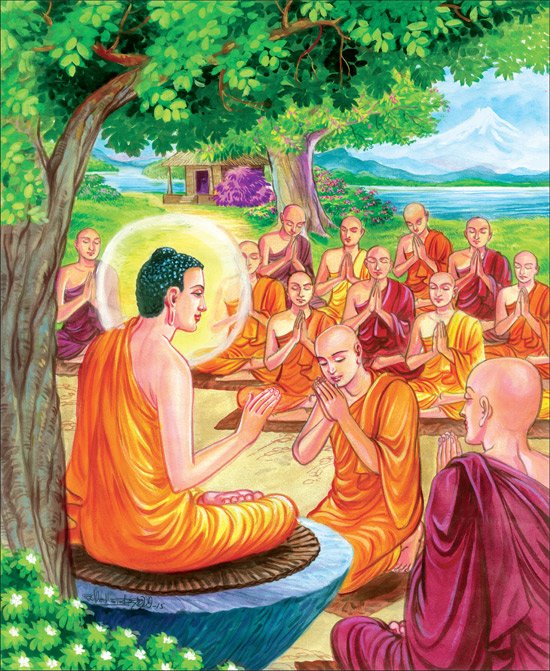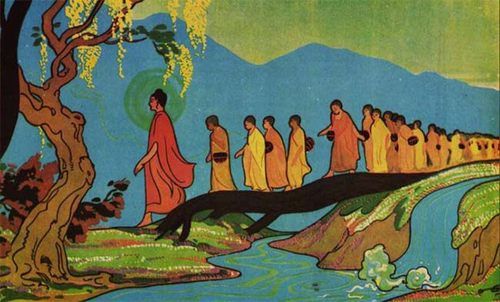TBAHD: Bodhisattva Dr Babasaheb Ambedkar ☸💙🧘♀️📿
The Man who was Siddharth Gautama☸💙🧘♀️📿
3. His Capacity to Lead☸💙🧘♀️📿
====
The Sangh☸ had no official head.
The Blessed One☸ had no authority over the Sangh☸.
The Sangh☸ was a self-governing body.
1/13
The Man who was Siddharth Gautama☸💙🧘♀️📿
3. His Capacity to Lead☸💙🧘♀️📿
====
The Sangh☸ had no official head.
The Blessed One☸ had no authority over the Sangh☸.
The Sangh☸ was a self-governing body.
1/13

What was, however, the position of the Blessed One☸ over the Sangh☸ and its members?
In this we have the evidence of Sakuldai and Udai, contemporaries of the Blessed One☸.
Once the Lord☸ was staying at Rajagraha in the bamboo grove.
2/13
In this we have the evidence of Sakuldai and Udai, contemporaries of the Blessed One☸.
Once the Lord☸ was staying at Rajagraha in the bamboo grove.
2/13

One morning d Lord went into Rajagraha for alms; but, deeming d hour too early, he thought of going to Sakuldai in Wanderers’ Pleasance;& thither he repaired
At d time, Sakuldai was sitting with a great company of Wanderers, who were making a great noise about being & not being
At d time, Sakuldai was sitting with a great company of Wanderers, who were making a great noise about being & not being

When from some way off, Sakuldai saw the Lord☸ coming, he hushed his company by saying:
“Be quiet, sirs; do not make a noise; here comes the recluse Gotama, who is a lover of silence.”
4/13
“Be quiet, sirs; do not make a noise; here comes the recluse Gotama, who is a lover of silence.”
4/13

So they became silent and the Lord came up.
Said Sakuldai: “I pray the Lord to join us; he is truly welcome; it is a long time since he last managed to come. Pray, be seated; here is a seat for the Lord.”
5/13
Said Sakuldai: “I pray the Lord to join us; he is truly welcome; it is a long time since he last managed to come. Pray, be seated; here is a seat for the Lord.”
5/13

The Lord sat down accordingly, asking Sakuldai what had been their theme and what was the discussion which had been interrupted.
“Let that pass for the moment,” answered Sakuldai; “you can easily gather that later on.”
6/13
“Let that pass for the moment,” answered Sakuldai; “you can easily gather that later on.”
6/13

Of late, when recluses and Brahmins of other creeds met together in the Discussion Hall, the topic was mooted, what a good thing, what a very good thing, for the Magdha people in Anga, that such recluses
and Brahmins—all at the head of confraternities or
7/13
and Brahmins—all at the head of confraternities or
7/13

followings, all well known and famous teachers, all founders of saving creeds, held in high repute by many people should have come to spend the rainy season at Rajagraha.
8/13
8/13

There was Purana Kassappa, Makhali Ghosala, Ajit Kesakambal, Pakudha Kacchayana, Sanjaya Belaiputta, and Nata-putta the Nigantha, all men of distinction and all of them here for the rains; and
among them there is also the recluse Gotama here, at the head of his confraternity &
among them there is also the recluse Gotama here, at the head of his confraternity &

following, a well-known and famous teacher, a founder of a saving creed, who is held in high repute by many.
Now, which of these lords, which of these recluses and Brahmins of such eminence as teachers, is esteemed, respected, venerated and adored by his disciples?
10/13
Now, which of these lords, which of these recluses and Brahmins of such eminence as teachers, is esteemed, respected, venerated and adored by his disciples?
10/13

And on what terms of esteem and respect do they live with him?
Said some: “Purana Kassappa gets no esteem or respect; no veneration or adoration, from his disciples; they live with him on no terms of esteem and respect.”
11/13
Said some: “Purana Kassappa gets no esteem or respect; no veneration or adoration, from his disciples; they live with him on no terms of esteem and respect.”
11/13

Time was when, as he was preaching his doctrine to some hundreds of his following, a disciple broke in with— “Don’t question Purana Kassappa, who does not know about it ; ask me who do; I will explain everything to your reverences.”
12/13
12/13

With arms outstretched Purana Kassappa tearfully remonstrated, saying: “Do be quiet, sirs; do not make a noise.”
13/13
13/13

• • •
Missing some Tweet in this thread? You can try to
force a refresh
























